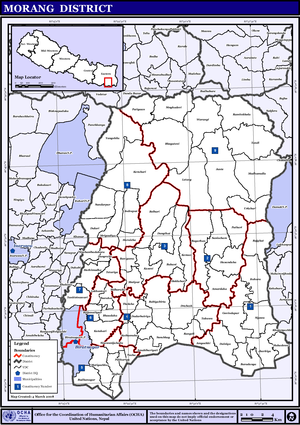| Morang | |
|---|---|
| — District — | |
| Location of Morang | |
| Country | |
| Region | Eastern (Purwanchal) |
| Zone | Kosi |
| Area | |
| - Total | 1,855 km2 (716.2 sq mi) |
| Population (2001) | |
| - Total | 843,220 |
| - Density | 454.6/km2 (1,177.3/sq mi) |
| Time zone | NPT (UTC+5:45) |
| Main language(s) | Limbu, Nepali |
Morang District, a part of Kosi Zone, is one of the seventy-five districts of Nepal, a landlocked country of South Asia. The district, with Biratnagar as its district headquarters, covers an area of 1,855 km² and has a population (2001) of 843,220.
The name Morang is derived from the name of the Limbu King Mawrong Mung Hang,
Kingdom of Morang until annexation to Gorkha Kingdom of King Prithivi Narayan Shah comprised all the terai lands east of Kosi river and west of Mechi river.
The name Morang came into use again after the shah kings divided the country into administrative districts and Morang was named after the old Morang Kingdom.
Morang is a district on the southern Tarai, or plains, of Eastern Nepal. Most of the land is taken up by rice and jute cultivation, though areas of sal forest remain along the northern part of the district where the plains meet the hills. A large amount of the forest was cleared in the last century, and in the process, many settlers migrated to the district from the hills and India. The Morang plains are one of the most culturally diverse regions in Nepal.
Most of the district is rural, though it is also home to Biratnagar, the 2nd largest city in Nepal after Kathmandu. Other minor towns include Urlabari, Biratchowk and Rangeli. It also boosts largest industrial area in the whole country, expanding from Rani Mills Area to Duhabi River. Raghupati Jute Mills and Dhanawat Matches are among the nation's oldest industries. The recent opening of Purvanchal University in Biratnagar, which offers graduate level courses in many disciplines of Arts and Liberal Sciences, is certain to make the place a college town as it attracts college graduates from most of the eastern part of the nation.
The district neighbours India to the south, and the districts of Sunsari to the west and north, Jhapa to the east, and Dhankuta to the north east.
Morang District is a southeastern district of Nepal and has a diversity of cultures and religions. It has a long history dating from the ninth century.[clarification needed][citation needed]
Village Development Committees (VDCs)
- Amaibariyati
- Amardaha
- Amgachhi
- Babiya Birta
- Bahuni
- Bairban
- Banigama
- Baradanga
- Bayarban
- Belbari
- Bhaudaha
- Bhogateni
- Biratnagar
- Budhanagar
- Dainiya
- Dangihat
- Dangraha
- Darbairiya
- Drabesh
- Dulari
- Govindapur
- Haraicha
- Hasandaha
- Hathimudha
- Hoklabari
- Indrapur
- Itahara
- Jante
- Jhapa Baijanathpur
- Jhorahat
- Jhurkiya
- Kadamaha
- Kaseni
- Katahari
- Kathamaha
- Kerabari
- Keron
- Lakhantari
- Letang
- Madhumalla
- Mahadeva
- Majhare
- Matigachha
- Motipur
- Mrigauliya
- Necha
- Pathari
- Patigaun
- Pokhariya
- Rajghat
- Ramite Khola
- Rangeli
- Sanischare
- Sidharaha
- Sijuwa
- Sinhadevi Sombare
- Sisabanibadahara
- Sisawanijahada
- Sorabhaj
- Sundarpur
- Takuwa
- Tandi
- Tankisinuwari
- Tetariya
- Thalaha
- Urlabari
- Warangi
- Yangshila
































No comments:
Post a Comment